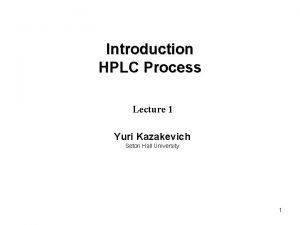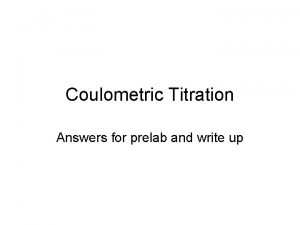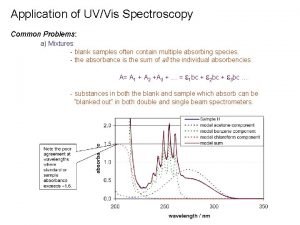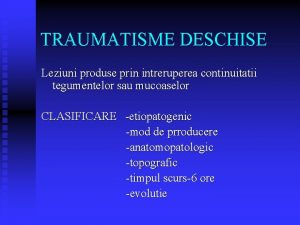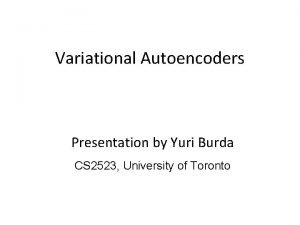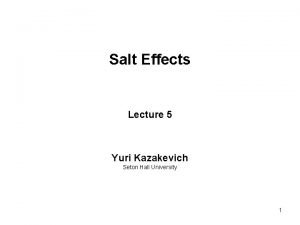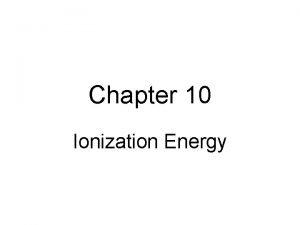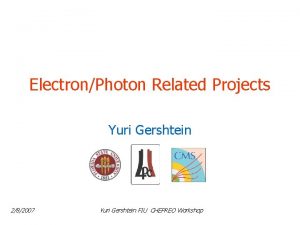Analyte Ionization Lecture 3 Yuri Kazakevich Seton Hall




![Ionization Equilibria [C 6 H 5 COO-][H+] Ka = [C H COOH] 6 5 Ionization Equilibria [C 6 H 5 COO-][H+] Ka = [C H COOH] 6 5](https://slidetodoc.com/presentation_image_h/993ccf779fda45d1c860f0f8524e8d4d/image-5.jpg)












- Slides: 17

Analyte Ionization Lecture 3 Yuri Kazakevich Seton Hall University 1

Reversed-Phase HPLC Retention The retention of ionizable analytes on the same bonded phase can be varied by: • Type of organic modifier • Concentration of organic modifier • Temperature • p. H of the mobile phase However the p. H of the eluent is dependent upon the type and concentration of the organic modifier and the temperature. 2

Introduction • p. H of the mobile phase affects: • • • analyte ionization and solvation interactions of the analytes with the stationary phase structure and properties bonded phase stability dissolution of silica matrix • p. H and the type of p. H modifier have a major impact on the selectivity alteration. • Recent developments in silica manufacturing and bonded phase chemistry significantly widened applicable p. H range (1. 5 - 10). 3

p. H Definition p. H is the negative logarithm of the proton concentration in the solution p. H = -log[H+] Equilibrium constants for acids are usually written in the following form: 4
![Ionization Equilibria C 6 H 5 COOH Ka C H COOH 6 5 Ionization Equilibria [C 6 H 5 COO-][H+] Ka = [C H COOH] 6 5](https://slidetodoc.com/presentation_image_h/993ccf779fda45d1c860f0f8524e8d4d/image-5.jpg)
Ionization Equilibria [C 6 H 5 COO-][H+] Ka = [C H COOH] 6 5 Ka=6. 4 x 10 -5 , p. Ka=4. 19 Increase of the proton concentration in the HPLC mobile phase shifts equilibrium to the left. p. Kb = 9. 4 p. Ka= 4. 6 p. Ka = 14 – p. Kb 5

Dependencies of Analyte Ionization on the p. H of the Mobile Phase [C 6 H 5 COO-] % ionized [C 6 H 5 NH 3+] p. Kb=9. 4 p. Ka=4. 2 p. H Aniline p. H Benzoic acid 6

Dependencies of Analyte Retention on the p. H of the Mobile Phase * Basic compound: p. Ka=6 Acidic compound: p. Ka=3 p. Ka=Analyte is 50% ionized 7 *Cs. Horvath, W. Melander, I. Molnar, Anal. Chem. 49 (1977) 142.

Dependencies of Analyte Retention on the p. H of the Mobile Phase Acid and base are both ionized at p. H=5 Acid and base are both neutral at p. H=5 • The retention of ionizable compounds at a certain p. H is dependent on their ionization state. 8

Dependencies of Analyte Retention on the p. H of the Mobile Phase RNH 3+ RNH 2 Base RCOO- p. H=2. 3 Base p. H=6. 0 Acid p. H=2. 3 Absorbance Acid p. H=6. 0 RCOOH 5 10 15 Retention Time (min. ) Ionization in general decreases hydrophobicity causing a decrease of HPLC retention. 9

Effect of p. H on Acidic Analyte Retention HPLC Conditions: Column – Zorbax Eclipse XDB-C 18, 150 mm x 4. 6 mm Flow rate – 1. 0 m. L/min Detection – UV 220 nm Injection volume – 1 L Mobile phase 30% Acetonitrile 70% 20 m. M Na 2 HPO 4 buffer; variable p. H acidic modifier = perchloric acid 10

Effect of p. H on Retention Factor of Acidic Analytes HPLC Conditions: Column – Zorbax Eclipse XDB-C 18, 150 mm x 4. 6 mm Flow rate – 1. 0 m. L/min Detection – UV 220 nm Injection volume – 1 L Mobile phase 30% Acetonitrile 70% 20 m. M Na 2 HPO 4 buffer; variable p. H acidic modifier = perchloric acid 11

Effect of p. H on Basic Analyte Retention pyridine p. Ka = 5. 17 2, 4 -lutidine p. Ka = 6. 74 CH 3 N H 3 C N CH 2 CH 3 4 -ethylpyridine p. Ka = 5. 87 CH 3 2, 3 -dimethylaniline p. Ka = 4. 70 CH 3 Chromatographic Conditions Column: 15 cm x 0. 46 cm Zorbax Eclipse XDB-C 18 Eluent: 90% Aqueous / 10% Me. CN Buffer: 10 m. M Na 2 HPO 4 • 7 H 2 O + x. H 3 PO 4 Flow rate: 1 ml/min Temp: 25 o. C 2 -picoline p. Ka=5. 96 phenylethylamine p. Ka=9. 83 N NH 2 N CH 3 NH 2 12 CH 3 Time (min. )

Effect of p. H on Basic Analyte Retention Chromatographic Conditions Column: 15 cm x 0. 46 cm Zorbax Eclipse XDB-C 18 Eluent: 90% Aqueous / 10% Me. CN Buffer: 10 m. M Na 2 HPO 4 • 7 H 2 O + x. H 3 PO 4 Flow rate: 1 ml/min Temp: 25 o. C 13

Retention of Aniline as a Function of p. H Aniline p. Ka=4. 6 Chromatographic Conditions Column: 15 cm x 0. 46 cm Zorbax Eclipse XDB-C 18 Eluent: 90% Aqueous / 10% Me. CN Aqueous: 10 m. M Na 2 HPO 4 • 7 H 2 O + x. HCl. O 4 Flow rate: 1 ml/min Time (min. ) 14

Peak Fronting • A condition where the rear of the peak is steeper than the front relative to the baseline. • Related to a secondary chemical equilibrium process -Analyte Ionization p. H of analysis is close to analyte p. Ka -Reaction of analyte with mobile phase components (ex. Aldehydes in presence of water under acidic or basic conditions) 15

Peak Tailing • A condition where the front of the peak is steeper than the rear relative to the baseline. • Appears when the analyte concentration exceed the linear range of adsorption isotherm. • Tailing (Depends upon acidity of silanols, ionization state of basic analyte and mobile phase p. H). 16

Concluding Remarks • p. H is an effective tool for adjustment of selectivity and retention • p. H can be used to optimize the resolution • Reversed phase packings are most stable between p. H’s 2 - 8. 17
 Yuri kazakevich
Yuri kazakevich Seton hall ptcas
Seton hall ptcas Blackboard seton hall law
Blackboard seton hall law Olga kazakevich
Olga kazakevich Carbohydrates
Carbohydrates Analyte concentration
Analyte concentration Vindecare per secundam
Vindecare per secundam Congenital sinus example
Congenital sinus example Altior fortior citior
Altior fortior citior Snug seton
Snug seton 01:640:244 lecture notes - lecture 15: plat, idah, farad
01:640:244 lecture notes - lecture 15: plat, idah, farad Lecture hall background
Lecture hall background Knozorov
Knozorov Yuri gorbachev paintings
Yuri gorbachev paintings Yuri krotov
Yuri krotov Yuri boykov
Yuri boykov Yuri burda
Yuri burda Yuri bezmenov
Yuri bezmenov
